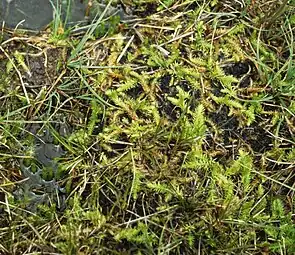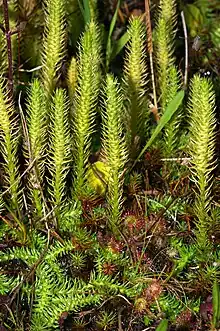| Lycopodiella | |
|---|---|
 | |
| Lycopodiella inundata | |
| Scientific classification | |
| Kingdom: | Plantae |
| Clade: | Tracheophytes |
| Clade: | Lycophytes |
| Class: | Lycopodiopsida |
| Order: | Lycopodiales |
| Family: | Lycopodiaceae |
| Subfamily: | Lycopodielloideae |
| Genus: | Lycopodiella Holub |
| Species | |
|
See text | |
Lycopodiella is a genus in the clubmoss family Lycopodiaceae. The genus members are commonly called bog clubmosses, describing their wetland habitat. The genus has a cosmopolitan distribution,[1] with centers of diversity in the tropical New World and New Guinea. In the past, the genus was often incorporated within the related genus Lycopodium, but was segregated in 1964.[2] In the Pteridophyte Phylogeny Group classification of 2016 (PPG I), Lycopodiella is placed in the subfamily Lycopodielloideae, along with three other genera. In this circumscription, the genus has about 15 species.[3] Other sources use a wider circumscription, in which the genus is equivalent to the Lycopodielloideae of PPG I, in which case about 40 species and hybrids are accepted.
Description
Lycopodiella are non-flowering plants. They have leafy rhizomes that grow along the ground and vertical, leafy shoots, also known as peduncles.[4] Fertile peduncles have strobili at the top of the shoot.[4] Individuals can have short, creeping rhizomes with simple strobili, branching rhizomes with many strobili, or anywhere in between.[1] The North American specimens are typically shorter, have thinner shoots, and have fewer vertical shoots in the North than specimen in the South.[5]
Life cycle
Lycopodiella life cycles include an independent sporophyte stage and a long-lived gametophyte stage.[6] Individuals reproduce by single-celled spores that disperse and germinate into small plants when in suitable conditions.[2] This part of the plant is called the gametophyte; it produces the eggs and sperm.[2] In Lycopodiella the gametophytes grow on the surface of the soil and are partially photosynthetic.[7] After fertilization, the embryos grow into sporophytes, which are larger spore-bearing plants.[2] The sporophyte is the vegetative part of the plant seen in nature. Juvenile individuals typically re-sprout in the spring or after a fire.[4] Individuals have a base chromosome number of 78.[8]
Taxonomy
In the Pteridophyte Phylogeny Group classification of 2016 (PPG I), Lycopodiella is placed in the subfamily Lycopodielloideae, along with three other genera (Lateristachys, Palhinhaea and Pseudolycopodiella).[3] In 2022, an additional monotypic genus, Brownseya, was segregated from Pseudolycopodiella to render the latter monophyletic.[9] Other sources do not recognize these genera, submerging them into Lycopodiella.[10][11]
Extant species

As of February 2023, the Checklist of Ferns and Lycophytes of the World recognized the following species:[12]
- Lycopodiella alopecuroides (L.) Cranfill – foxtail clubmoss; North and South America
- Lycopodiella andicola B.Øllg. - northern Andes Mountains
- Lycopodiella appressa (Chapm.) Cranfill – southern clubmoss, appressed bog clubmoss; eastern North America, Cuba
- Lycopodiella duseniana (B.Øllg. & P.G.Windisch) B.Øllg. - Brazil
- Lycopodiella geometra B.Øllg. & P.G.Windisch – southern South America
- Lycopodiella inundata (L.) Holub – marsh clubmoss or bog clubmoss; circumboreal cool temperate
- Lycopodiella longipes (Hook. & Grev.) Holub – Central and South America, Cuba
- Lycopodiella margueriteae J.G.Bruce – northern prostrate clubmoss; central and eastern United States
- Lycopodiella mathewsii (Hook.) Holub – northern South America
- Lycopodiella prostrata (R.M.Harper) Cranfill – feather stem clubmoss; southeastern United States
- Lycopodiella subappressa J.G.Bruce, W.H.Wagner & Beitel – northern appressed clubmoss; central and eastern United States
- Lycopodiella tupiana (B.Øllg. & P.G.Windisch) B.Øllg. – southern South America
Some hybrids have also been described:[12]
- Lycopodiella × brucei Cranfill
- Lycopodiella × copelandii (Eiger) Cranfill
- Lycopodiella × gilmanii A.Haines
- Lycopodiella × robusta (R.J.Eaton) A.Haines
Distribution and habitat
Lycopodiella is found worldwide, but typically in temperate and tropical areas, a majority of which are found in North and South America.[13] Individuals are typically found in terrestrial lowlands or montane forests on poor soils.[14] Much of the soils are sandy and saturated and have little to no organic layer.[2]
North America
The known Lycopodiella in North America consists of six species and four hybrids.[15] All but one species of Lycopodiella, Lycopodiella inundata, are limited to the East coast, Gulf of Mexico, and/or Great Lakes region.[15] L. inundata is found from New England to Alaska and down into California.[15]
References
- 1 2 Wikström, Niklas; Kendrick, Paul (2000). "Relationships of Lycopodium and Lycopodiella Based on Combined Plastid rbcL Gene and trnL Intron Sequence Data". Relationships of Lycopodium and Lycopodiella Based on Combined Plastid RBCL Gene and TRNL Intron Sequence Data. 25 (3): 496.
- 1 2 3 4 5 Gilman, Arthur (2004). Lycopodiella alopecuroides (L.) Cranfill Foxtail bog clubmoss. pp. i, 3.
- 1 2 PPG I (2016). "A community-derived classification for extant lycophytes and ferns". Journal of Systematics and Evolution. 54 (6): 563–603. doi:10.1111/jse.12229. S2CID 39980610.
- 1 2 3 Weakley, Alan (2010). Flora of the Southern and Mid-Atlantic States. pp. 18–19.
- ↑ Haines, Arthur (2003). "Lycopodiella ×gilmanii (Lycopodiaceae), a New Hybrid Bog Clubmoss from Northeastern North America". American Fern Journal. 93 (4): 196–197. doi:10.1640/0002-8444(2003)093[0196:LGLANH]2.0.CO;2. S2CID 85779335.
- ↑ Winther, Jennifer; Friedman, William (2007). "Blackwell Publishing Ltd Arbuscular mycorrhizal associations in Lycopodiaceae". New Phytologist. 177 (3): 790–801. doi:10.1111/j.1469-8137.2007.02276.x. PMID 17971070.
- ↑ Conservation Assessment for Northern Appressed Club-moss and Northern Prostrate Club-moss
- ↑ Arana, Marcelo; Gonzalez, Andrés; Bonifacino, Mauricio; Brussa, Carlos (2017). "A Revision of Lycopodiaceae from Uruguay". International Journal of Advanced Research in Botany. 3 (4): 28.
- ↑ Chen, De-Kui; Zhou, Xin-Mao; Rothfels, Carl J.; Shepherd, Lara D.; Knapp, Ralf; Zhang, Liang; Lu, Ngan Thi; Fan, Xue-Ping; Wan, Xia; Gao, Xin-Fen; He, Hai; Zhang, Li-Bing (2022). "A global phylogeny of Lycopodiaceae (Lycopodiales; lycophytes) with the description of a new genus, Brownseya, from Oceania". Taxon. 71 (1): 25–51. doi:10.1002/tax.12597. S2CID 243840820.
- ↑ Christenhusz, Maarten J.M. & Chase, Mark W. (2014). "Trends and concepts in fern classification". Annals of Botany. 113 (9): 571–594. doi:10.1093/aob/mct299. PMC 3936591. PMID 24532607.
- ↑ "Lycopodiella Holub". Plants of the World Online. Royal Botanic Gardens, Kew. Retrieved 2019-12-05.
- 1 2 Hassler, Michael (21 February 2023), "Lycopodiella", World Ferns. Synonymic Checklist and Distribution of Ferns and Lycophytes of the World, 14.10, retrieved 2023-02-25
- ↑ Øllgaard, Benjamin (1992). "Neotropical Lycopodiaceae - An Overview". Annals of the Missouri Botanical Garden. 79 (3): 711–712. doi:10.2307/2399760. JSTOR 2399760.
- ↑ Sahidan, NorShahidah; Choo, Chee Yan; Latiff, Abdul Rais; Jaman, Razali (2012). "Variations of huperzine A content in Lycopodiaceae species from tropics". Chinese Journal of Natural Medicines. 10 (2).
- 1 2 3 "BONAP's North American Plant Atlas". 2014.